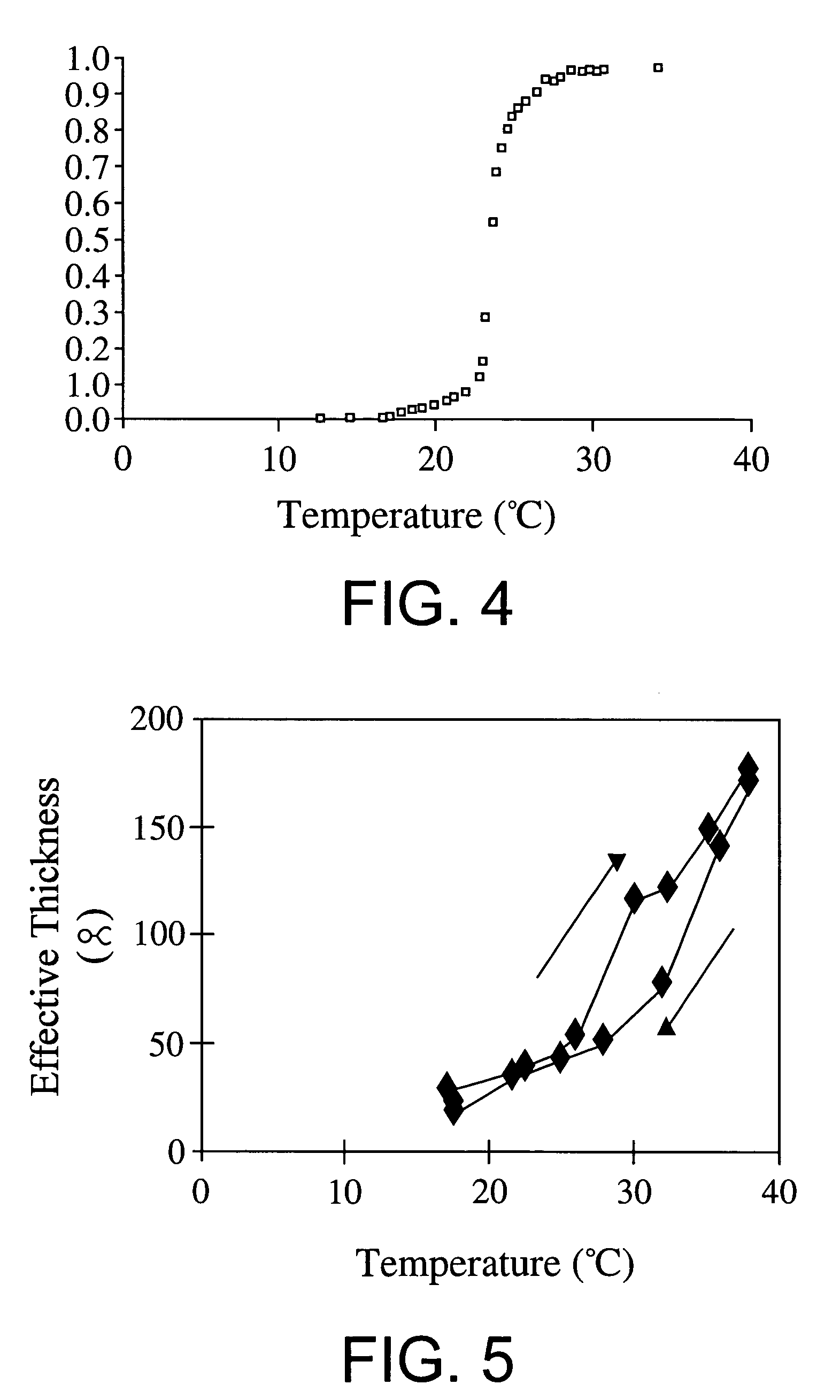Methods of using bioelastomers
a bioelastomer and polymer technology, applied in the field of bioelastic polymers, can solve the problems of irreversible denature of proteins, difficult to broad implement the approach to sensor regeneration, and generally accompanied by an extremely slow dissociation rate (off rate) of protein-ligand complexes
- Summary
- Abstract
- Description
- Claims
- Application Information
AI Technical Summary
Benefits of technology
Problems solved by technology
Method used
Image
Examples
example 1
Production of a Thioredoxin-ELP Fusion Protein and Poly-NIPAAm / Am Copolymer
[0106]Gene Synthesis. The synthetic gene for the ELP-1 mer was constructed from four 5′-phosphorylated, PAGE purified synthetic oligonucleotides (Integrated DNA Technologies, Inc.), ranging in size from 86 to 97 bases. The oligonucleotides were annealed (100 pmol of each oligonucleotide in 50 μl ligase buffer, NEB Inc.) to form double-stranded DNA spanning the ELP gene with EcoRI and HindIII compatible ends. The annealed oligonucleotides (2 pmol) were then ligated using T4 DNA ligase (10:1 insert:vector molar ratio) into EcoRI-HindIII linearized and dephosphorylated pUC-19 (NEB, Inc.). Chemically competent E. Coli XL1-Blue cells were then transformed with the ligation mixture, and incubated on ampicillin-containing agar plates. Colonies were initially screened by blue-white screening, and subsequently by colony PCR to verify the presence of an insert. The DNA sequence of a putative insert was verified by auto...
example 2
Immunoassay with a Thioredoxin-ELP Fusion Protein
[0112]Immunoassays are commonly used to detect analytes such as enzymes, hormones, drugs, and other molecules of interest in complex biological mixtures. By definition, an immunoassay relies on the specific binding of an antigen by an antibody, but assays using other biological high affinity binding partners (e.g., ligand-cell surface receptor, inhibitor-enzyme, etc.) can also be employed in an analogous manner. A number of different immunoassay formats have been developed to detect and / or quantitate the levels of analytes; for a review of immunoassays, see PCT Patent Application WO 86 / 06492.
[0113]Here we report an immunoassay in which one of the reactants (e.g., either the antigen or the antibody) is genetically fused to an elastin-like polypeptide (ELP), which we define as oligomeric polypeptides composed of the pentapeptide repeat Val-Pro-Gly-X-Gly (where X, the guest residue, can be any amino acid). ELPs undergo a reversible phase...
example 3
Sensor Regeneration with a Thioredoxin-ELP Fusion Protein
[0138]This examples shows that an environmentally-responsive polypeptide tag can be introduced into a model protein by genetic engineering, that the polypeptide tag allows the fusion protein to adsorb to a hydrophobic surface, and that the fusion protein can be desorbed from the surface by altering the solvation of the protein in response to an environmental signal, thereby allowing regeneration of the surface back to the protein-free substrate. This approach is generic for the following reasons: first, the introduction of enviromentally-triggered properties in a target protein simply involves gene-level N or-C-terminal fusion of the peptide codons into a cloned or synthetic gene, which is easily achieved by standard molecular biology manipulations. Second, fusion proteins containing this polypeptide tag are rendered environmentally-responsive, and this appears to be a fairly general phenomena. Finally, the polypeptide tag can...
PUM
| Property | Measurement | Unit |
|---|---|---|
| MW | aaaaa | aaaaa |
| temperatures | aaaaa | aaaaa |
| temperatures | aaaaa | aaaaa |
Abstract
Description
Claims
Application Information
 Login to View More
Login to View More - R&D
- Intellectual Property
- Life Sciences
- Materials
- Tech Scout
- Unparalleled Data Quality
- Higher Quality Content
- 60% Fewer Hallucinations
Browse by: Latest US Patents, China's latest patents, Technical Efficacy Thesaurus, Application Domain, Technology Topic, Popular Technical Reports.
© 2025 PatSnap. All rights reserved.Legal|Privacy policy|Modern Slavery Act Transparency Statement|Sitemap|About US| Contact US: help@patsnap.com



